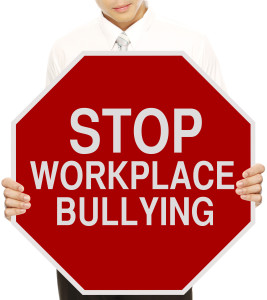 World Wrestling Entertainment (WWE)© is recognized all around the world for body slams, suplexes, and super kicks. WWE recently introduced a new type of tag team partnership: a national partnership with the Boys and Girls Club of America to support bullying prevention efforts utilizing its athletes. This comes on the heels of the White House sponsoring a movement against bullying. Of course, there’s also the National Bullying Prevention Awareness Month every October. As we laud these efforts, we should not forget that bullying extends beyond playgrounds and schools into the workplace.
World Wrestling Entertainment (WWE)© is recognized all around the world for body slams, suplexes, and super kicks. WWE recently introduced a new type of tag team partnership: a national partnership with the Boys and Girls Club of America to support bullying prevention efforts utilizing its athletes. This comes on the heels of the White House sponsoring a movement against bullying. Of course, there’s also the National Bullying Prevention Awareness Month every October. As we laud these efforts, we should not forget that bullying extends beyond playgrounds and schools into the workplace.
California employers need to know their rights and responsibilities to avoid getting into a headlock when it comes to bullying in the workplace.
California’s Efforts to Stomp Out Bullying in the Workplace
Last year saw an amendment to the Fair Employment and Housing Act, AB 2053, we covered which took effect January 1, 2015. The new law takes aim at abusive conduct in the workplace by requiring employers with 50 or more employees to include, as part of their sexual harassment training, a section on preventing abusive conduct and workplace bullying.
Critics say the law has no teeth, because it is not linked to a protected category such as age, gender, religion, or race. And the new law does not give employees a right of action to sue for bullying—at least not yet! What this law does, however, is attempt to quash bad behavior that doesn’t involve any of the protected categories.
Employers Tackling Bullying
Even though AB 2053 hasn’t changed the legal landscape much yet, the law has sparked a conversation about workplace bullying and forced employers to treat it as the serious issue that it is. On top of the potential legal pitfalls of bullying (wherever bullying is associated with a protected characteristic), employers should consider both the monetary and non-monetary costs of workplace bullying. Bullying not only creates a potentially intimidating workplace and can prompt workplace violence; it also creates costs in terms of employee turnover, training, and absenteeism.
One way employers can tackle this issue head-on is to review and revise, if necessary, company polices and guidelines. While the law does not require anti-bullying policies, addressing bullying conduct can help employers demonstrate that they have made good-faith efforts to prevent harassment or discrimination stemming from bullying.
Employers should also remember the effects an anti-bullying policy will have on their discipline and performance improvement policies. That may mean weaving in details when writing up an employee or even revising the discipline sections to include incidents of bullying.
Grappling With the Future
In California, to date, most of the substantive anti-bullying laws have focused on schools. But with a growing national movement against bullying, of which AB 2053 is a part, it would not be a surprise to see similar legislation enacted for the workplace. Accordingly, it is wise for employers to get ahead of the curve and consider implementing:
- Prohibitions on bullying and other abusive conduct in the workplace.
- A clear path on how to properly report bullying in the workplace
- A prohibition on retaliation for reporting bullying
- A re-emphasis on regular training of employees
Whether or not bullying is now addressed by a “law without teeth,” bullying is a serious issue. Our California Workplace Solutions lawyers can help review or craft policies addressing bullying and advise on methods to keep the workplace “bullying free.”
Edited by Chelsea Mesa.